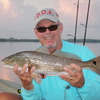We recently fished sand bars near Turtle Bay off Charlotte Harbor. The main bar is located in the mouth of Turtle Bay and usually holds good numbers of redfish and snook this time of year.
This trip didn't disappoint.
We landed severel redfish on topwater plugs and 3-inch Gulp Shrimp on 1/8-ounce jig heads. The largest red went 37 inches and an estimated 15 pounds.
It won't be long until waders and warm clothing will be required for those taking to the water in kayaks.
Even though we live in southwest Florida, the water can get quite chilly, sometimes dipping into the 50s. During winter, we dress for the worst and pray for the best.
Last year, the winter was so warm that we rarely had to wear waders while fishing from the kayak. We dressed comfortably and wore wading boots.
But such warm winters are the exception rather than the rule.
For a typical winter outing, we dress in layers: T-shirt, fishing shirt, sweat shirt, jacket, long-legged fishing pants (or jeans), and waders. We can take off a few layers as the air warms during the day. We wear waders for a couple of reasons: 1. They keep you dry and warm; 2. They come in handy if you want to get out of the kayak to fish and when getting in and getting out of kayak.
During winter we often experience extreme low tides. And it's during these conditions that kayaks shine. We can often get to waters that power boats can't reach. One of our favorite trips is to Whidden Creek off Gasparilla Sound near Placida. It's about a one-hour paddle from the ramp to Whidden Creek. But it's worth every minute spent.
During extreme low tides, fish are forced into any sand holes in the area. Fishing in those conditions is often like fishing in a bathtub. Often, there are so many fish in a particular hole that you can catch 20 or more fish without having to move. When one hole slows down, it's simply a matter of moving to the next.
We either use spinning tackle or fly gear. When spinning, we employ 6 1/2 to 7-foot rods, 15-pound PowerPro braided line and 20- to 25-pound fluorodcarbon leader.
We use a variety of lures, including 3-inch Berkley Gulp Shrimp on 1/8-ounce jig heads and D.O.A. Shrimp.
When fly fishing, few flies can beat an olive-and-white Clouser Deep Minnow.
When fishing potholes, realize that the fish aren't necessarily in the middle of the depression. They can be, but usually they'll hold up along the edges, facing the tide. And don't overlook any grass patches in the hole.
When fishing sand holes, you most likely encounter spotted seatrout, redfish, jack crevalle, ladyfish, pompano and flounder.
This time of year also is a good time to target tailing redfish. This is an exciting game. Imagine paddling in 12 to 18 inches of water with redfish tails all around you!
Recently, we took a busman's holiday of sorts to fish with noted south Florida peacock bass guide Alan Zaremba of Hollywood. We joined Zaremba and Marty Arostegui (holder of 198 world records) for a day of fishing in the canals of south Florida. Our target was snakeheads, an excotic species that has found its way into the south Florida fresh waters.
Arostegui holds several fly rod and line class world records on snakeheads.
We were successful in catching snakeshead, but not on breaking any records. Arostegui and I caught five between us. In addition, we caught and released 20 largemouth bass, a trio of peacock bass, a bluegill, Mayan cichlid and a mudfish.
For information about Alan Zaremba and peacock bass fishing in south Florida, give him a call at (954) 961-0877 or visit his webisite at http://www.floridapeacocks.com/florida.html. His email address is sflpeacock@aol.com.



